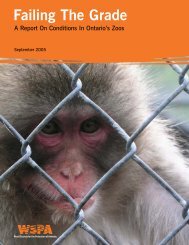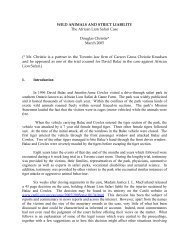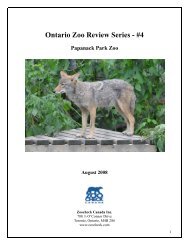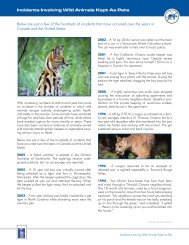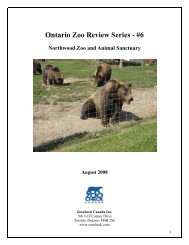What's a Polar Bear Doing in the Tropics? - Animal Concerns ...
What's a Polar Bear Doing in the Tropics? - Animal Concerns ...
What's a Polar Bear Doing in the Tropics? - Animal Concerns ...
You also want an ePaper? Increase the reach of your titles
YUMPU automatically turns print PDFs into web optimized ePapers that Google loves.
1.5 Welfare concerns for polar bears <strong>in</strong> captivity:International scientific studies<strong>Polar</strong> bears are poor candidates for captivity, even <strong>in</strong> <strong>the</strong> best ofcircumstances. Captive polar bears are notorious for <strong>the</strong>ir tendency toexhibit repetitious stereotypic behaviours. These behaviours <strong>in</strong>clude headsw<strong>in</strong>g<strong>in</strong>g,pac<strong>in</strong>g, tongue-flick<strong>in</strong>g, and circular or to-and-fro patterns ofswimm<strong>in</strong>g. 36 O<strong>the</strong>r abnormal behaviours that have been described <strong>in</strong>cludehead twist<strong>in</strong>g and head weav<strong>in</strong>g. <strong>Polar</strong> bears are particularly well known forpac<strong>in</strong>g 13 and probably <strong>the</strong> most universal movement observed <strong>in</strong> almost anyzoo <strong>in</strong> <strong>the</strong> world by polar bears is <strong>the</strong> expression of “head-body turns”.Accord<strong>in</strong>g to WSPA, this movement is often seen as part of pac<strong>in</strong>gstereotypies, but may also be expressed as part of swimm<strong>in</strong>g stereotypies. 21.5.1 British zoos studiesStudies undertaken at British Zoos <strong>in</strong> <strong>the</strong> 1980s and 1990s documented andexam<strong>in</strong>ed <strong>in</strong> detail <strong>the</strong> abnormal and stereotypic behaviours displayed by<strong>the</strong> polar bears <strong>the</strong>re. 36,37,38In one survey carried out <strong>in</strong> British zoos between 1989 and 1991, all polarbears <strong>in</strong> <strong>the</strong>se zoos showed stereotyped behaviours at one time or ano<strong>the</strong>r,with <strong>the</strong> most common be<strong>in</strong>g that of pac<strong>in</strong>g to-and-fro. 36 In this survey, zoopolar bears were recorded spend<strong>in</strong>g an average of thirty-three per cent of<strong>the</strong>ir day engaged <strong>in</strong> stereotyped behaviours. One polar bear spent sixty percent of its time engaged <strong>in</strong> stereotyped behaviour. 36 In a separate study,abnormal behaviour was seen to be displayed by all polar bears <strong>in</strong> fiveBritish zoos. 38With captive polar bears, stereotypic behaviour is particularly resistant tochange. 36 It is not only wild caught polar bears that are susceptible todevelop<strong>in</strong>g <strong>the</strong>se abnormal behaviours <strong>in</strong> captivity. Captive born <strong>in</strong>dividualsappear just as prone to development of abnormal behaviours, <strong>in</strong>clud<strong>in</strong>gstereotypic behaviours. 38Captive polar bears are also prone to o<strong>the</strong>r forms of abnormal behaviour.<strong>Polar</strong> bears have been recorded display<strong>in</strong>g pronounced <strong>in</strong>activity or apathy,for example sitt<strong>in</strong>g “trance-like” <strong>in</strong> one squatt<strong>in</strong>g position for hours at atime, star<strong>in</strong>g at a wall. 38 It has been suggested that <strong>the</strong> orig<strong>in</strong>al cause of thispo<strong>in</strong>tless squatt<strong>in</strong>g behaviour was boredom, this boredom <strong>the</strong>n led to a formof ennui, <strong>the</strong>n <strong>the</strong> bear became mentally moribund. 38 It has long beenrecognised that cerebral degeneration is a common feature amongstopportunist species kept <strong>in</strong> captivity. 38 Apathy <strong>in</strong> captive animals has beenrecorded by numerous scientists <strong>in</strong>clud<strong>in</strong>g Hediger (1950, 1955), 39,40 Meyer-Holzapfel (1968) 41 and Morris (1964) 42 .What’s a polar bear do<strong>in</strong>g <strong>in</strong> <strong>the</strong> tropics?13www.acres.org.sg




